Advertisements
Advertisements
प्रश्न
Find the potential difference between the points A and B and between the points B and C of the figure in steady state.

उत्तर
Equivalent capacitance of the circuit can be calculatesd as,
Ceq:-
\[1 \mu F\text{ is in parallel with, }C = \frac{1}{\frac{1}{(3 + 3)} + \frac{1}{(1 + 1)}} = \frac{3}{2}\mu F\]
So, \[C_{eq} = \frac{3}{2} + 1 = \frac{5}{2} \mu F\]
V = 100 V
Total charge in the circuits is,
\[Q = C_{eq} V = \frac{5}{2} \times 100 = 250 \mu c\]
As the volatge across 1μf is 100 V, therfore charge stored on 1 μf capacitors = 100 μC
Charge flowing from A to B = (250 - 100) = 150 μC
Ceq between A and B is 6 μf.
Potential drop across AB,
\[V = \frac{Q}{C}\]
\[ \Rightarrow V_{AB} = \frac{150}{6} = 25 V\]
Potential drop across BC = (100 - 25) = 75 V
APPEARS IN
संबंधित प्रश्न
Draw a schematic diagram and explain the working of Van de Graff generator device.
Is there any restriction on the upper limit of the high voltage set up in Van de Graff generator machine? Explain.
The figure shows a plot of three curves a, b, c, showing the variation of photocurrent vs collector plate potential for three different intensities I1, I2and I3 having frequencies v1, v2 and v3 respectively incident of a photosensitive surface.
Point out the two curves for which the incident radiations have same frequency but different intensities.
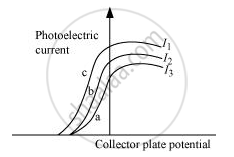
A 100 pF capacitor is charged to a potential difference of 24 V. It is connected to an uncharged capacitor of capacitance 20 pF. What will be the new potential difference across the 100 pF capacitor?
Find the potential difference `V_a - V_b` between the points a and b shown in each part of the figure.
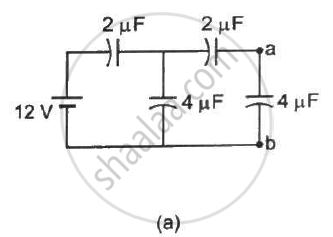
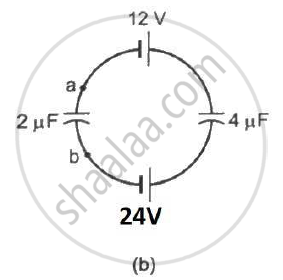
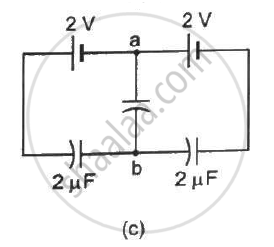
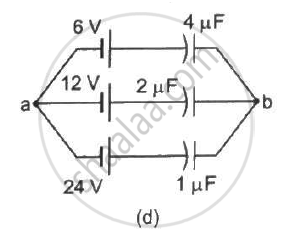
A charge of `+2.0 xx 10^-8 C` is placed on the positive plate and a charge of `-1.0 xx 10^-8 C` on the negative plate of a parallel-plate capacitor of capacitance `1.2 xx 10^-3 "uF"` . Calculate the potential difference developed between the plates.
A charge of 20 µC is placed on the positive plate of an isolated parallel-plate capacitor of capacitance 10 µF. Calculate the potential difference developed between the plates.
The capacitance between the adjacent plates shown in figure is 50 nF. A charge of 1⋅0 µC is placed on the middle plate. (a) What will be the charge on the outer surface of the upper plate? (b) Find the potential difference developed between the upper and the middle plates.
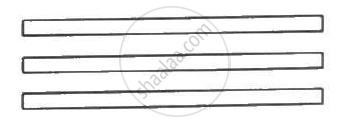
The capacitance between the adjacent plates shown in the figure is 50 nF. A charge of 1.0µC is placed on the middle plate. If 1.0 µC is placed on the upper plate instead of the middle, what will be the potential difference between (a) the upper and the middle plates and (b) the middle and the lower plates?
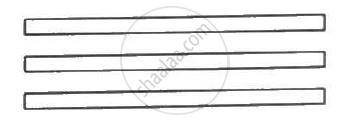
A capacitor having a capacitance of 100 µF is charged to a potential difference of 50 V. (a) What is the magnitude of the charge on each plate? (b) The charging battery is disconnected and a dielectric of dielectric constant 2⋅5 is inserted. Calculate the new potential difference between the plates. (c) What charge would have produced this potential difference in absence of the dielectric slab. (d) Find the charge induced at a surface of the dielectric slab.
If a positive charge moves in the direction of the electric field ______.
The unit of potential difference as used in electrical circuits is ________.
Two metal pieces having a potential difference of 800 V are 0.02 m apart horizontally. A particle of mass 1.96 × 10–15 kg is suspended in equilibrium between the plates. If e is the elementary charge, then charge on the particle is ______.
A and B are two points in an electric field. If the work done in carrying 4.0C of electric charge from A to B is 16.0 J, the potential difference between A and B is:
On moving a charge of 20 C by 2 cm, 2 j of work is done then the potential difference between the point is:-
A bullet of mass of 2 g is having a charge of 2 µc. Through what potential difference must it be accelerated, starting from rest, to acquire a speed of 10 m/s.
